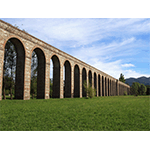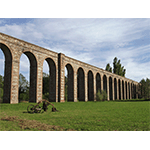Nottolini Aqueduct
The necessity to equip Lucca with a large aqueduct to supply the city with water of good quality and thus solve the problems of a hygienic nature, was perceived and confronted already in the early 18th century. From that time, mathematicians and hydraulic engineers engaged in a lengthy discussion, elaborating various projects which did not lead to concrete results, however. The aqueduct was built only in the following century by royal architect Lorenzo Nottolini who also took into consideration several earlier hypotheses. Work began in 1823 and, following several interruptions, ended in 1851. The water was drawn from several springs on the northern slope of Mount Pisano and – as Antonio Mazzarosa wrote in his Guida di Lucca for the illustrious guests who gathered in the city for the 5th Congress of Italian Scientists – «passing through several layers of stones and gravel, first becoming pure and clear, it then pours over sixteen mouths in a tunnel under a stream». A large part of its conveyance works, built between 1825 and 1840, are still visible today in the parkland of the Monumental Aqueduct of Guamo.
Built between 1823 and 1825 in an elegant neoclassical style, the little temple-cistern of Guamo collected water from the springs. Inside, it has a basin divided into two parts. Water was channelled inside the conduit that passed over a row of more than 400 arches in brick and masonry for a length of about 3250 metres, the series of which is today interrupted by the A11 motorway from which a spectacular view is offered.
The water arrived at the little temple-cistern of San Concordio, a lovely, circular-plan building in the neoclassical style. «The water – continues Mazzarosa – pours from the conduit into this large marble basin; from here it falls into two channels made of very large smelted iron tubes which convey it to the city in the square beside the cathedral, after a length of 1290 arms […]. The effects of the metal lengthening and shortening due to heat and cold have been ingeniously provided for, rendering the tubes occasionally moveable, so as to avoid the ruptures that have recently occurred in other aqueducts. The metal canals are situated in an underground tunnel». The hydraulic system of the aqueduct was completed by a system of fountains that furnished the urban centre.
From the little temple of San Concordio, a footpath follows the fascinating course of the aqueduct through the countryside of Lucca.
****************************
Texts by Graziano Magrini
English translation by Victor Beard
Last update 01/feb/2008





